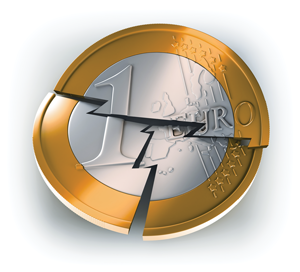The euro crisis
 The future of the euro, and Ireland’s place in it, remains uncertain. Stephen Dineen looks at the country’s currency options.
The future of the euro, and Ireland’s place in it, remains uncertain. Stephen Dineen looks at the country’s currency options.
Depending on the outcome of the euro crisis, Ireland has four main currency options. It could stay in the economic and monetary union, quit the euro and establish an independent currency, or quit the euro and establish a currency linked to sterling or several currencies.
Staying in the euro is seen by many economists as beneficial because it provides Ireland with currency stability, lower business costs and cheaper borrowing (through lower interest rates).
Commentators say the case for remaining in the euro is compelling because of the consequences of leaving. If Ireland left the euro and reverted to the punt, having a devalued currency but with euro-denominated debt would mean greater debt in euro terms. The country would have difficulties borrowing after a likely debt default (even if this does reduce national debt).
Sizeable outflows of deposits from Irish banks would be likely, in turn exacerbating the banking system’s problems. Interest rates would rise to attract funds into Ireland, but this would adversely affect mortgage holders. While exports might be boosted by trading in a weaker currency, trade with euro zone countries is easier at present than might be the case (particularly for small businesses, which would have to deal in multiple currencies).
A new currency
For University of Limerick economics lecturer Dr Stephen Kinsella, “the introduction of a new currency would mean an immediate depreciation of that currency, implying our debt loads would probably double.” It is likely, he told eolas, that Ireland would default, resulting in “a collapse in living standards of more or less the entire population as pensions, pay, social welfare and consumer spending all drop.”
The option of adopting a new currency and paying off all national debts is “completely unmanageable”. With the ‘real’ price of euro denominated debt probably doubling, Ireland would be insolvent for a decade or longer. This in turn would lead to the default that had been avoided.
Some of the main arguments made for leaving the euro to establish a new punt centre on competitiveness, debt reduction and economic planning. Establishing a new Irish punt, devalued relative to the euro, would strengthen competitiveness. With its own currency, the Government might be in a stronger position to default or restructure some of the national debt (general government debt was estimated at 107 per cent of GDP in 2011).
Fiscal, economic and monetary autonomy would enable Ireland to implement economic policies that are conducive to its own economic cycle.
Having inappropriate interest rates can overheat or inhibit an economy, depending on the phase of an economic cycle. Ireland cannot set its own interest rates. An inappropriate currency value can reduce competitiveness. The ECB sets interest rates therefore euro zone interest rates and euro exchange rates are designed to suit the euro-area, not Ireland specifically. For a small open economy like Ireland these are significant factors. Another benefit highlighted is that trade done by Irish businesses abroad would be more valuable when overseas’ currencies are traded back into Irish currency.
The sterling option
A variation on a new Irish currency would be one linked to sterling. This would involve the punt’s value tied to sterling and interest rates tracking those set by the Bank of England. This has several advantages. Ireland’s economic cycle is similar to that in the UK, so having the same interest rates would be beneficial. It trades considerably with the UK and many retail distribution markets would welcome the move. The established value between sterling and the euro would facilitate an easier redenomination of contracts.
Sterling’s stability would be preferable to a new, independent currency subject to the volatility of the currency market.
A third non-euro option is an Irish currency pegged to a weighted basket of currencies, as was discussed during the 1993 currency crisis. The basket of currencies consisted primarily of sterling and the deutschmark. Under a scenario with a 0.5 weighting given to the deutschmark and 0.5 given to sterling, if sterling depreciated against the deutschmark by 10 per cent, then rather than the punt appreciating against sterling by 10 per cent under the deutschmark peg it would have appreciated by a smaller amount (5 per cent). This would have led to the Irish punt depreciating against the deutschmark by 5 per cent.
This scenario was viewed as an advantage at the time, according to University College Cork academic Dr Ella Kavanagh, because “it would reduce the negative effects of sterling depreciations on short run Irish competitiveness relative to if the Irish pound was pegged to the deutschmark.” This arrangement was considered more credible on financial markets relative to a peg to the deutschmark only, if sterling was depreciating against the deutschmark.
“On the inflation side,” she added, “it was considered better than a sterling peg in terms of inflation although inferior to a deutschmark peg.”
The disadvantages of reverting to an Irish punt (linked to other currencies or not) include the possible consequences of leaving the euro mentioned above. Lone currencies are believed to be more susceptible to currency speculators and volatile markets. The sterling option is tempered by evidence that a new punt would have a higher value than sterling. Analysis by Bank of America Merrill Lynch’s Richard Cochinos and David Grad in November 2011 showed Ireland to be one of few euro zone countries (with Germany and the Netherlands) to have a competitive advantage over the US at current exchange rates. If so, Ireland does not need to devalue, nor would a new punt depreciate.
In the debate on currency, Ireland’s fiscal and monetary options are sometimes framed in terms of the Argentinian and Icelandic experiences. Both countries, with their own currencies, defaulted on debt and soon recovered economically. However, the comparison is limited.
“No example that includes a country with its own monetary policy is quite right for Ireland,” says Kinsella. “We don’t have one. If we did things would be much easier.” He says that we should look to Hungary (which is bound by the EU Growth and Stability Pact convergence rules but currently negotiating an EU-IMF bailout), or Portugal in six months time (which is in the euro and receiving an EU-IMF bailout) “when they burn their bondholders”.
For Kavanagh, the Argentinian and Icelandic lessons are that to avoid crises there is a need to “co-ordinate fiscal policy with monetary policy and with financial regulation.” She adds: “They are not independent.”
Irish currency options
- remain in the euro
- a new Irish punt
- a new Irish punt linked to sterling
- a new Irish punt pegged to a weighted basket of currencies





